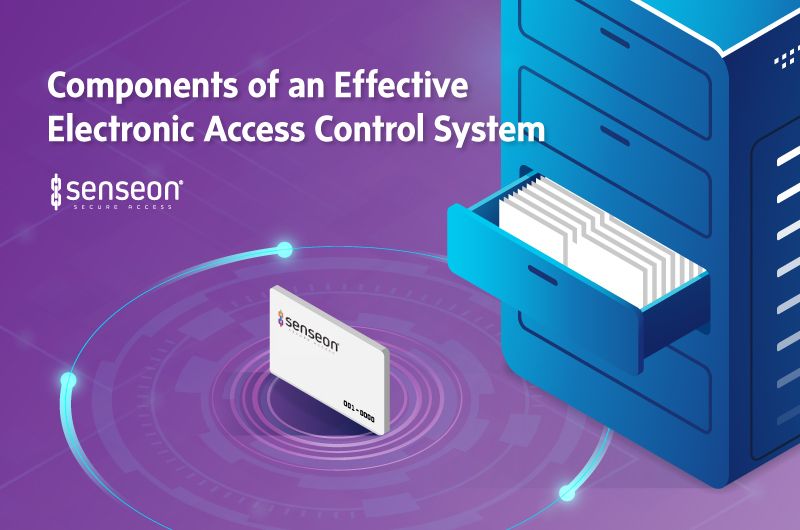Retailers face unique security needs that extend beyond locking exterior doors. Managers must tackle the revolving door of employee turnover as well as protect information stored in offices, inventory stocked in storerooms, and valuables kept in display cases.
While converting to an electronic locking system is a good start, what retailers really need is a comprehensive access management system. Having a system that will restrict access to authorized personnel will lower the cost of key replacement as well as protect inventory and digital assets.
Electronic access control systems require managers and employees to present credentials for authentication to enter any secure area. Administrators replace codes instead of keys, saving the company money. It is also possible to customize access credentials down to an individual cabinet, drawer, or display case.
Electronic access control systems have two common components:
- A system to present qualifications
- A system to compare presented credentials against an approved list for authorization
Presenting Credentials
Electronic access control systems require the verification of credentials before entering a secure area. The three primary forms of entry include access cards, keypads or touchscreens, and biometric measures.
Access cards replace physical keys and come in many forms, such as a key card, fob, employee badge, or smartphone app. Access control systems allow administrators to assign a unique code to each individual. Within seconds, administrators can revoke or grant access.
Keypads and touchscreens can also be used to verify credentials. Instead of swiping or tapping a card, the user enters a password, code, or PIN.
Biometrics measures verify the individual using a fingerprint, palm scan, retina scan, voice recognition, or other identifying feature. The software converts the biometric reading into a computer recognized code.
At the lock, a reader accepts the user credentials and sends the presented data to a control panel for verification. Systems can utilize a keypad or touch screen, a card swipe, or a contactless reader. The latter accepts credentials using RFID, Wi-Fi, Bluetooth, or Z-wave technologies. Near field communication allows staff members to open a door when the access card comes within two to six inches of the reader, creating a seamless entry without compromising security.
Single or Multi-Factor Verification
Access control systems can use a combination of credentials, allowing customization with either single or multi-factor verification. For example, the administrator might require both a password and an access card or a biometric measure with a card swipe to verify credentials.
Other security measures might include open delays, auto relocking, or dual authorization , which requires two authorized individuals to present credentials in order to open a secure area.
Authenticating the User
Access card readers are another essential component of an access control system. The reader accepts the codes from an access card and sends that information to the control panel for authentication. The reader determines the maximum number of codes available and will dictate how users present credentials.
The hardware consists of the electronic lock securing the door or drawer. Once the system verifies the presented credentials, it will unlock the door. Electronic locks are either electromagnetic or electromechanical, depending on the technology needed to secure the area.
Software controls the functions of the system. It defines the capabilities, store codes, and records activity. The software can be compatible with various devices, allowing companies to integrate multiple security measures into a single access management system. The use of software can also allow remote access to the system from any computer with a reliable internet connection.
The control panel communicates with the reader. It connects all of the components within the system and can be located at the reader or a remote location operated from a computer, smartphone, or tablet. The panel stores approved credentials, makes system decisions, processes activity, and can store data for future retrieval. Systems that include an audit trail will track credential acceptances and rejections in addition to a time and date stamp and the code of the individual presenting credentials.
There are three types of access control panels and readers, which determine how the reader and control panel communicate with each other: basic readers, semi-intelligent readers, and intelligent readers.
Basic readers operate as a single unit from the point of entry. The user enters credentials at the reader, which is often a keypad or touch screen. Basic readers are only available as a stand-alone device.
Semi-intelligent readers have a separate reader and control panel at the point of entry. The reader accepts credentials and sends that information to the control panel, which makes system decisions. The device can accept administrative changes at the reader or from a remote location using Bluetooth, Wi-Fi, Z-wave, or RFID technologies. Semi-intelligent readers can control multiple doors or drawers from the same control panel but cannot integrate with other systems.
Intelligent readers are the most sophisticated access control systems available and offer speed, integration, and tracking capabilities. In addition to verifying credentials, these readers can include independent memory and processing power, allow administrators access to audit trails, and integrate with other systems utilized by the company.
Managers can remotely access tracking logs, adjust credentials, and operate multiple locks and entry points from a single control panel.
Using Sub-Controllers to Expand the Capabilities of an Access Control System
Adding sub-controllers can expand the use and capabilities of an access control system. Semi-intelligent and intelligent readers can have multiple sub-controllers within the system, allowing a single reader to control multiple locks. In this configuration, the reader connects to a sub-controller, which connects to the central server. With this technology, a jewelry store with 15 display cases can connect the locks on each case to a single system through multiple sub-controllers.
Integrating an Access Control System with Other Security Measures
Integrated systems require intelligent readers, linked to a main controller or a system of sub-controllers. The network can transmit data quickly, allows managers to change credentials remotely, and tracks verification attempts through an audit trail. An integrated system can operate with existing hardware and software, giving system administrators more oversight control and accommodating more users.
Final Thoughts
The specific components required for an access control system will depend on the needs of the business. Every company faces a host of unique security challenges that an electronic access control system can mitigate, improving overall security measures.
Senseon helps companies mitigate inventory and data security risks by providing cabinet-level electronic access management solutions within a variety of industries. From audit trail to auto relock, Senseon brings the security of building-level access control to the cabinet-level to keep your valuables safe. Visit our website or contact us to learn more about how you can expand your security to the cabinet-level.






